Volume 3, Number 10, December 2005
[UA Universe] [Ask the Doctors] [Artist Interview] [Analog Obsession]
[Support Report] [The Channel] [Plug-In Power] [Playback] [Featured Promotion]
[Graphic-Rich WebZine]
[Back Issues] [UA Home]
Analog Obsession: The Mid-Side (MS) Stereo Microphone Technique
by Joseph Lemmer
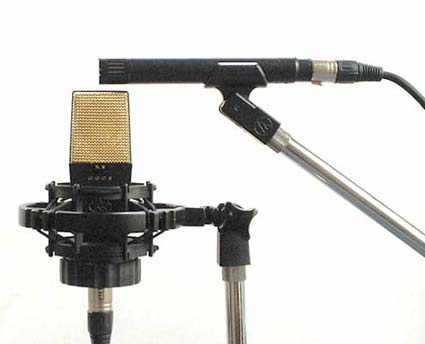 |
First, it is totally mono-compatible. If your stereo production is collapsed to mono, the stereo information cancels out completely and you are left only with the sound of the middle or mid mic. This is why this method is often used in television production. Even if your recording is guaranteed to always play in stereo (practically impossible), with Mid-Side you will experience a cohesiveness of stereo imaging that does not occur if your stereo source is not mono-compatible.
“Even if your recording is guaranteed to always play in stereo (practically impossible), with Mid-Side you will experience a cohesiveness of stereo imaging that does not occur if your stereo source is not mono-compatible.”
Second, you can adjust the amount of stereo information in your mix after recording, while mixing. Of course, you can do this with your panpots in any stereo recording, but unlike all the other techniques mentioned, with Mid-Side you are not mixing together a left and right mic, you are bringing in more and more of the mono source-one microphone.
Last, also unlike the other techniques mentioned, your mics don't have to be matched. While matched mics probably yield the best stereo field definition, you can get great results with two different types and brands of mics. (In fact, even if you have a matched pair of mics with switchable polar patterns, you might find their response is different in the different patterns.) Experimentation is encouraged!
| Alan Blumlein, responsible for a host of audio innovations, patented the Mid-Side stereo microphone technique in 1933. |
The typical description for Mid-Side miking is something like, "Aim a cardioid mic at the sound source. Place a figure 8 mic in the same plane as the cardioid-as close to the cardioid as possible, with the lobes of the figure 8 perpendicular to the address of the cardioid. Then, run the signals of the mics into a sum-and-difference matrix to get stereo: Mid + Side = Left; Mid - Side = Right."
Say what? "Sum-and-difference matrix"? Neo? Is that you?
It is much, much easier than it sounds. You probably already have a sum-and-difference matrix and don't even know it. Every DAW has one. Any mixer with phase reverse on channels has one, too. In the worst case, if your mixer does not have phase switches and you don't own a DAW, you can still create a sum-and-difference matrix with a phase-reverse cable-this is a little trickier, though, so we won't cover that here. There are also products with Mid-Side matrixes built in. These are really convenient and make the process even easier.
This is what you need:
- A figure 8 mic. This is the "side" mic.
- An omni, cardioid or figure 8 mic. This is the "mid" or mono mic. Please note, most people use a cardioid for the mid mic, which is why you should try the other two as well!
- One of the following:
a. A DAW, or
b. A mixer with phase-reverse switches, or
c. A dedicated product with a sum-and-difference matrix.
Mid-Side Microphone Setup
Take your cardioid, omni or figure 8 and set it up as if you were recording the source in mono-however that may be. This is the "mid" mic. Now set up the figure 8 mic (the "side" mic) directly above or below the mid mic without touching. Adjust the position of the figure 8 mic so that its pickup patterns are facing at a 90-degree angle to the left and right of the direction of the cardioid. For the purpose of this article, make sure the normal front of the mic is facing left. See Figs. 1 through 3 below.
That's it. That's your mic setup.
The Sum-and-Difference Matrix
The sum-and-difference matrix is so much easier than the name implies. You can set this up before or after recording. For the purposes of this article, let's assume you have recorded the mid and side mics to two tracks on your multitrack recorder, and you are working with recorded signals.
- Route the recorded mid mic track to a channel in your mixer. Make sure that channel is panned to the center.1.
- Route the side mic track to a second channel. Pan that channel all the way to the left.2.
- Mult or copy the side mic track to a third channel. Pan that channel all the way to the right. Flip the phase of this channel. If you are using a mixer, you can use a direct out, a prefader send or your patchbay to create the mult'ed third channel.3.
- If you are in a DAW, link, gang, join, group or do whatever your DAW calls it to make the second and third channel's level change together.
- Adjust the level of the second and third track (the side mic) relative to the mid (mono) mic to get more or less stereo information. See Figs. 4 and 5
That's it. You're Mid-Side miking! Some MS recorded drum loops are provided below so you can try this out. See Fig. 6
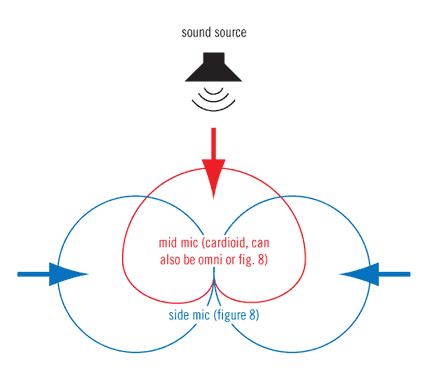 |
|
Figure 1: Mid-Side setup diagram
|
 |
|
Figure 2: A Mid-Side setup with an AKG 414 as the side mic (set to figure 8) and an Audio Technica 4051 as the mid mic (using the cardioid capsule).
|
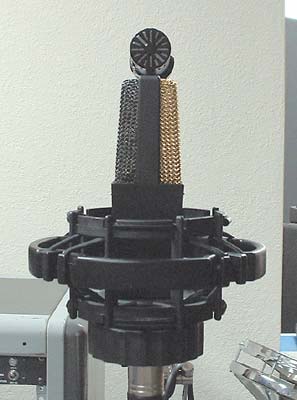 |
|
Figure 3: The Mid-Side setup from the front.
|
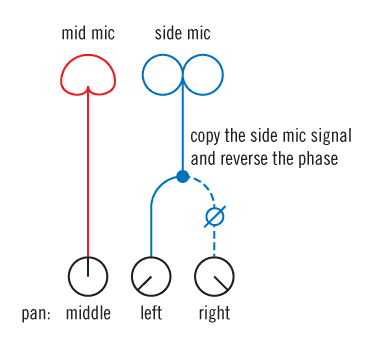 |
|
Figure 4: Mid-Side signal flow
|
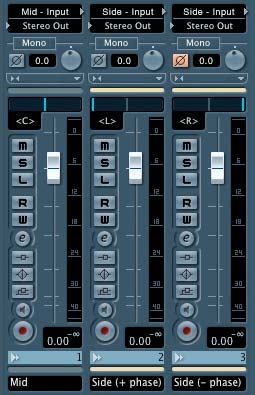 |
|
Figure 5: mixer setup. If you don't have a phase button in your DAW, you can flip the phase of the recorded file (sometimes called "invert"). Make sure you are phase reversing a copy!
|
Mid-Side with a cardioid as the mid mic: Mid-Side with an omni as the mid mic: If you have a DAW, you can download the mid and side (.wav) files separately and set up the sum-and-difference matrix yourself: |
Figure 6: audio samples